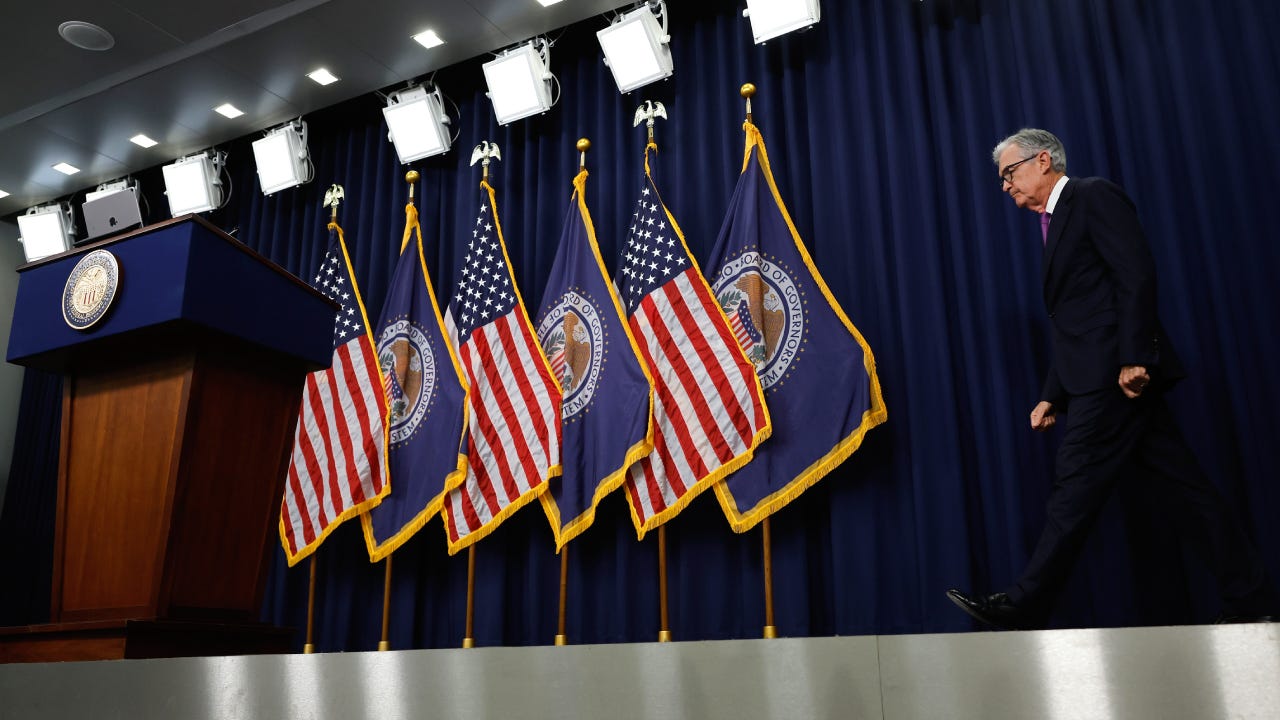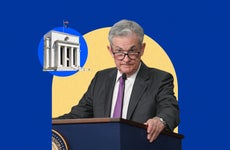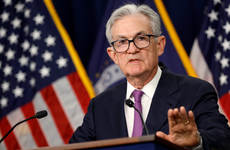Take these 12 steps as the Federal Reserve keeps interest rates high

The Bankrate promise
At Bankrate we strive to help you make smarter financial decisions. While we adhere to strict , this post may contain references to products from our partners. Here's an explanation for .
Hotter-than-expected inflation at the start of 2024 is leading Federal Reserve officials to keep interest rates higher for even longer.
At the Fed’s June rate decision, officials left interest rates in their current target range of 5.25-5.5 percent, the highest since 2001 and where they’ve been since July 2023.
Those high rates are forcing consumers to face money dilemmas they haven’t had to debate for years. After briefly retreating, mortgage rates in Bankrate’s national survey of lenders have been hovering above 7 percent since February, as multiple reports from the Department of Commerce and Bureau of Labor Statistics suggest that inflation remains stubborn. Even forms of consumer credit once seen as low-cost debt — such as home equity lines of credit (HELOCs) — are now hitting the highest level in over two decades.
There are also some bright spots to paying more for money this year. For starters, savers can earn 5 percent or more on their cash if they shop around, Bankrate data shows. It’s also now easy to find a yield that eclipses inflation if you keep your cash in a high-yield savings account, meaning your money isn’t losing purchasing power just by sitting on the sidelines.
But the ultimate question is when the Fed will begin cutting interest rates. Fed Chair Jerome Powell has indicated that officials may need even more time than they initially expected to feel comfortable lifting off the brakes, for fear that it could make hot inflation tougher to eradicate.
Here’s your 12-step plan for taking charge of your wallet after the Fed’s latest rate decision.
Interest rates took the elevator going up but are going to take the stairs coming down.— Greg McBride, CFA | Bankrate chief financial analyst
1. Get a snapshot of your personal finances
In today’s high-rate era, consumers should get an idea of where they are with their personal finances, including how much debt and savings they have.
Print out statements from any account housing liquid cash — or money you could withdraw without penalty. Those are most likely savings accounts, but they could also be funds in a money market account or no-penalty CD. Even better, note each account’s annual percentage yield (APY).
Next, list your debt, including your outstanding balance and the annual percentage rate (APR) you’re charged. Keep tabs on whether that debt has a fixed or variable rate, and note how much interest you pay per month.
Then, keep track of the income and expenses flowing in and out of your budget each month.
The goal of taking a hard look at your personal finances is to hopefully inform you of how fragile you might be in today’s high-rate environment. You might also be able to identify easy budget cuts or debt to work on eliminating. Individuals who live outside of their means and borrow to fund their expenses will feel the most squeezed.
2. Know what’s good debt and bad debt — and eliminate the latter
Consumers with high-interest debt should take careful note. Those borrowers are hit hardest in a high-rate environment, and the Fed’s 11 rate hikes have brought punch after punch.
“Anything you can do to pay off your balances faster and make adjustments in your budget, so you don’t have to rely on your lines of credit and carry debt from month to month, that’s the best strategy,” says Bruce McClary, spokesperson for the National Foundation for Credit Counseling.
High-interest debt commonly comes from a credit card. Even when the Fed’s rate held near zero, the average credit card rate hovered slightly higher than 16 percent, according to Bankrate data. If you don’t pay off your balance in full each billing cycle, that’s likely costing you hundreds — if not thousands — of extra dollars a month.
Consider consolidating your outstanding balance with a balance-transfer card to help chip away at your high-cost debt. Most cards start borrowers with a rate as low as zero percent for a specified number of months — currently a maximum of 21 months — before transitioning to the regular APR. The economy’s resilience is also good for borrowers with credit card debt: Issuers are less inclined to take their consolidation offers off the market.
Meanwhile, if your credit score has improved in recent months, you might also be able to find a better rate on the market than the one you’re currently paying. And even though the Fed appears more likely to cut interest rates than raise them, consumers are still recommended to refinance any variable-rate loans into fixed-rate loans, so long as it’s well below the rate they’re currently paying, McBride says.
One benefit to tracking how much you pay in interest each month is, it can also help you determine whether you’d save money by transferring your debt — a process that comes with fees.
When deciding whether to refinance, be sure to determine whether you can afford the fees — and that the savings from the new payment are worth it.
And if you’re carrying fixed-rate debts such as mortgages or car loans with “low and mid-to-single-digit rates,” McBride says, you shouldn’t feel hard-pressed to prioritize paying them off. You might be better off putting that money toward other avenues that meet your financial goals, such as saving or investing.
3. Shop around for the most competitive borrowing rates
Shopping around will be one of the most important steps a consumer can take in a high-rate environment.
Mortgage rates aren’t the only financing costs that have surged. Home equity loans, adjustable-rate mortgages, credit cards, car loans and more are also the highest since before the Great Recession.
Financial experts typically recommend comparing offers from at least three lenders before locking in a loan.
The new landscape signals an end to the record-low rates of the coronavirus pandemic-era — and even the lower rates borrowers were accustomed to in the decade after the financial crisis. Yet, some lenders might be more inclined to offer better deals than others to lure new customers in a slower market. Financial experts typically recommend comparing offers from at least three lenders before locking in a loan.
4. Work on boosting your credit score
If there’s any factor that inhibits consumers’ ability to borrow cheaply more than the Fed, it’s their personal credit scores. Most of the time, financial companies save the best rate for the so-called “safest” borrowers: those with good-to-excellent credit scores and a reliable credit profile.
Companies may even grow pickier about who they approve for loans. Half of applicants have been rejected for a loan or financial product since the Fed started raising interest rates, a Bankrate survey from March found. Rejection rates were highest for individuals with credit scores below 670.
To improve your credit score, concentrate on making all of your debt payments on time and keeping your credit utilization ratio as low as possible — the two factors with the biggest influence on how your rating is calculated.
5. Think twice about big-ticket purchases, but you can’t always time the market
The Fed looks unlikely to cut borrowing costs significantly in 2024, but cheaper interest rates could nonetheless still be coming — eventually, that is.
But consumers can’t always successfully time the market. A car can break down or a roof can need repairing regardless of the rate environment.
“If your dishwasher breaks and you need a new one but it means financing it, are you going to wash the dishes by hand in the next six months in hopes that you can finance it at a lower rate at the end of the year?” McBride says. “Rates aren’t going to come down fast enough or soon enough to validate that decision.”
Yet, some forward-planning where possible can pay off when the Fed is on the verge of a turning point.
Even modest rate reductions can translate to major savings. For instance, financing $500,000 on a 30-year fixed-rate mortgage at 6 percent would come with a monthly principal and interest payment that’s 11 percent cheaper than where it would be today, with rates currently at 7.08 percent, Bankrate’s mortgage calculator shows.
6. Keep up frequent communication with your credit card issuers
Issuers might be inclined to give you a new APR if your credit score improves, NFCC’s McClary says. If they don’t, you’ll at least know even more that it’s time to shop around or take advantage of a balance-transfer card.
It leads to another crucial step in your financial plan: opening up the channels of communication with your credit card issuer.
“It’s sad how few people talk to their creditors when times are good because it’s when you have those conversations, you realize a lot of really great things you could be doing to save even more money,” he says.
In today’s high-rate environment, it’s worth reviewing your cardholder agreement and making sure you know how your issuer calculates your APR. Credit card companies, by law, have to give cardholders a 45-day notice if they’re going to increase their cardholder’s interest rate.
“Credit card companies do have some latitude in deciding when and how much to increase a cardholder’s interest rates within the confines and constraints of the Card Act,” McClary says. “It’s in those areas that the details are going to be in the cardholder agreement.”
7. Don’t let inflation keep you from saving
Elevated inflation might make consumers hesitant to sit on large piles of cash out of fear that their money could lose some of its purchasing power, but experts say saving is more important now than ever given recession risks and economic uncertainty.
It’s also easier than you may think to now find a savings rate that beats those price pressures. All 10 banks ranked for Bankrate’s best high-yield savings accounts in June offer yields higher than headline inflation.
A crucial part of any financial plan is having cash for emergencies. Experts typically recommend storing six months’ worth of expenses in a liquid and accessible account. But even if you can’t afford to stash that much away, any little bit can help protect you from accruing high-cost credit card debt when an unexpected expense pops up.
“Building a rainy day fund is really important, even if the interest rate you’re earning on those funds is lower than the inflation rate,” says Mike Schenk, deputy chief advocacy officer at the Credit Union National Association. “Put a little bit into a savings account over time, and before you know it, you’ll have a chunk of savings that can give you a better night’s sleep at the very least.”
8. Look around for the best savings yields
Be prepared to shop regularly for the best savings yields on the market, even if it means moving your funds to a different bank to capitalize on a better return.
Typically, online banks can reward their depositors with higher yields because they don’t have to pay the overhead associated with operating a brick-and-mortar financial institution.
The 10 best high-yield online banks ranked for June 2024 are currently offering an average yield of 5.1 percent, nearly nine times the national average and 400-500 times higher than yields at Chase and Bank of America. Those banks offer yields as high as 5.3 percent and as low as 5.01 percent. The market’s top-yielding online bank, meanwhile, is paying a 5.55 percent APY, Bankrate data shows.
You shouldn’t sacrifice liquidity or FDIC insurance for yield chasing, especially if your savings account is where you’re keeping your emergency fund. But if an account on the market offers terms that fit your financial needs, you may want to consider switching accounts.
“Every month, a different bank is going to have the best rate,” says Gary Zimmerman, CEO of MaxMyInterest. “Since an FDIC-insured savings account is a commodity, it doesn’t really matter which bank. The whole idea of, ‘I’m going to pick a bank,’ that doesn’t make any sense.”
9. If you already have an emergency fund, now’s the time to lock in a long-term CD
Savings yields fluctuate, and banks often don’t wait for a rate hike or rate cut to adjust how much they’re paying depositors in interest. Even the mere expectation of the Fed reducing rates in the near-future can send yields tumbling. Case in point: The highest-yield 2-year CDs are offering consumers an APY of 4.76 percent, and the top 5-year CDs are offering 4.5 percent. Both have already edged lower, peaking at 5.75 percent and 4.85 percent, respectively.
One way to make sure you can take advantage of higher rates for a longer time horizon? Consider locking in a longer-term CD, particularly one with a 2-year or 5-year maturity.
The highest-yield 2-year CDs are offering consumers an APY of 5.36 percent, and the top 5-year CDs are offering 4.55 percent. Both have already edged lower, peaking at 5.75 percent and 4.85 percent, respectively.
If you don’t mind locking away your cash for the entire length of the CD, it might be a strong — and safe — way to add some yield to your portfolio of investments, including for retirees. And right now, with rate cuts delayed, there’s no monetary benefit to waiting to lock one in, McBride says.
“With rates still rising and inflation now declining, it is the best of both worlds for savers,” McBride says. “Consider locking in longer-term CDs, which are peaking now.”
10. Start recession-proofing your finances
The odds of the Fed slowing inflation without causing a recession look brighter than they did in 2022, but it’s still wise to prepare for the unexpected. Monetary policy will keep putting the brakes on the economy as long as borrowing costs stay high.
“Raising interest rates is putting the brakes on the economy,” McBride says. “The harder they press the brakes, the sharper it’s going to slow down. The cumulative impact of ongoing rate hikes is where you’re likely to see a slowdown in economic activity and the labor market.”
Recessions aren’t always as severe as the coronavirus pandemic, the Great Recession or even the Great Depression almost a century ago. They do, however, mean increased joblessness, reduced hiring or job security, as well as market volatility.
That means it’s important to start thinking about how you’d stay afloat in a recession. No matter how strong the U.S. economy is, it’s always important to live within your means, chip away at your debts and make sure you can cover a period of joblessness.
11. Think about your career and income opportunities
When the cost of living rises or the economic outlook seems shaky, one of the best investments you can make is in yourself. Think about ways to increase your earnings opportunities over your lifetime, whether by getting more training, education or increasing your skills. Joblessness is typically lower for those with a bachelor’s degree or higher — even during recessions, according to data from the Labor Department.
“You have to be looking down the road because what’s far more impactful to household finances than an increase in interest rates is a job loss or a significant decline in wealth,” McBride says. “Those are the types of things that happen in a recession.”
12. Tune out market volatility if you’re investing for the long term
High rates typically cause market dysfunction. That’s partially by design: More expensive borrowing costs tighten financial conditions, soaking up extra liquidity in the marketplace. In 2022, for example, the S&P 500 plunged roughly 20 percent, the worst year for the major stock index since 2008.
Financial markets haven’t been as downtrodden in 2024, with the S&P 500 already smashing multiple record highs. Yet, volatility has already begun as investors brace for the Fed to cut interest rates even later than they were initially expecting.
That volatility shouldn’t mean anything for long-term investors, especially those who are saving for retirement. If you’re investing over a time horizon that spans decades, you’ll no doubt have to endure both booms and busts.
Remember: Downdrafts in the market are a powerful buying opportunity. Investing can also help you beat inflation over time, though it’s something you should think about mostly after you have a solid savings cushion.
“Investing does make sense because you will more than likely have to take a little bit of risk to earn returns that are higher than the inflation,” CUNA’s Schenk says.
Bottom line
The failures of SVB, First Republic and Signature Bank a year ago also illustrate that something can always break when rates rise — but those cracks will be for nothing if the Fed can’t get control of inflation first.
Defeating rapid price pressures has been the Fed’s ultimate goal with raising interest rates. For U.S. central bankers, however, that might be one of the most difficult jobs yet. Fed officials want to be sure that inflation isn’t just moving to target — but will stay there.
“Inflation is easing, but has further to go to get to the 2 percent level,” McBride says. “Robust consumer demand and continued strength in the labor market could lead to inflation moving back up — or at least not moving lower as consistently as we’ve seen in recent months. The Fed will want some more time to evaluate the progress on inflation before hinting as to when rate cuts may begin.”
Related Articles

Biggest winners and losers from the Fed’s interest rate decision

Will stubborn inflation force the Fed to raise interest rates again?

Fed keeps interest rates at 22-year high as economy stays surprisingly strong

Federal Reserve leaves interest rates unchanged, sees no more hikes this year